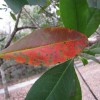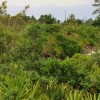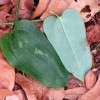 Bay trees in Florida can be difficult to distinguish because their leaves all look alike at first glance. The leaves of bays are all simple, large, elliptical, and evergreen. In addition, several bay species grow in overlapping ranges and habitats. Many times two or more different species of bay will be found growing right next to one other. This 7-page fact sheet includes a dichotomous key to help in the identification of common bay trees found in Florida. A basic description and photos of each species help with the identification process. Written by Lynn Proenza and Michael Andreu, and published by the UF Department of School of Forest Resources and Conservation, September 2013.
Bay trees in Florida can be difficult to distinguish because their leaves all look alike at first glance. The leaves of bays are all simple, large, elliptical, and evergreen. In addition, several bay species grow in overlapping ranges and habitats. Many times two or more different species of bay will be found growing right next to one other. This 7-page fact sheet includes a dichotomous key to help in the identification of common bay trees found in Florida. A basic description and photos of each species help with the identification process. Written by Lynn Proenza and Michael Andreu, and published by the UF Department of School of Forest Resources and Conservation, September 2013.
http://edis.ifas.ufl.edu/fr379
Tag: Lynn Proenza
Common Woody Plants of Florida Scrub Ecosystems (FOR305/FR373)
 The purpose of this fact sheet is to help identify a few of the more common woody plant species found in Florida’s scrub ecosystems. In the individual plant descriptions, words that appear in bold font are considered to be key field characteristics that will aid in identification of the species. This 14-page fact sheet was written by Lynn Proenza and Michael Andreu, and published by the UF Department of School of Forest Resources and Conservation, October 2012.
The purpose of this fact sheet is to help identify a few of the more common woody plant species found in Florida’s scrub ecosystems. In the individual plant descriptions, words that appear in bold font are considered to be key field characteristics that will aid in identification of the species. This 14-page fact sheet was written by Lynn Proenza and Michael Andreu, and published by the UF Department of School of Forest Resources and Conservation, October 2012.
http://edis.ifas.ufl.edu/fr373
Key to Nine Common Smilax Species of Florida (FOR307/FR375)
 Identifying species found in Smilax the genus can be difficult because species resemble one another closely. One must be careful to use detailed descriptions in order to correctly identify a specimen. Smilax species are important because they can provide shelter and food for wildlife and have provided humans with medicine, food, and dyes. Twelve Smilax species are found in Florida. This 8-page fact sheet covers the nine more common species that one may encounter in the state. Written by Lynn Proenza and Michael Andreu, and published by the UF Department of School of Forest Resources and Conservation, January 2013.
Identifying species found in Smilax the genus can be difficult because species resemble one another closely. One must be careful to use detailed descriptions in order to correctly identify a specimen. Smilax species are important because they can provide shelter and food for wildlife and have provided humans with medicine, food, and dyes. Twelve Smilax species are found in Florida. This 8-page fact sheet covers the nine more common species that one may encounter in the state. Written by Lynn Proenza and Michael Andreu, and published by the UF Department of School of Forest Resources and Conservation, January 2013.
http://edis.ifas.ufl.edu/fr375